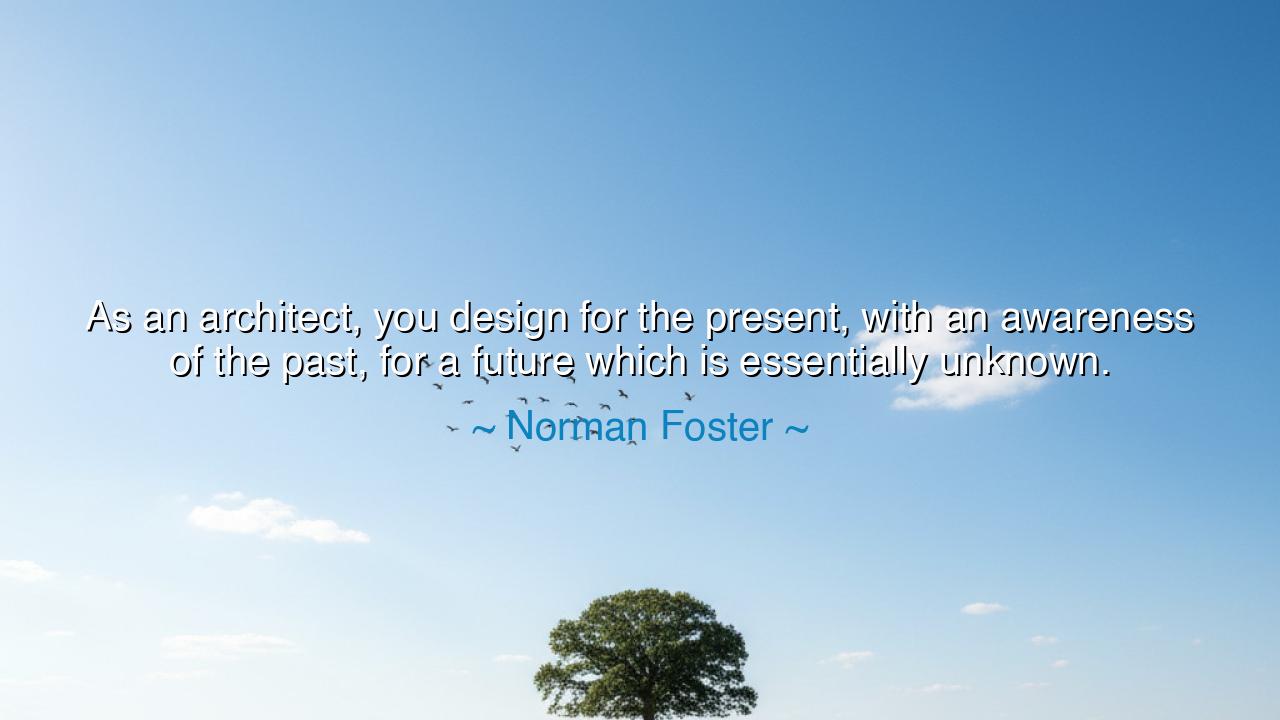
As an architect, you design for the present, with an awareness of
As an architect, you design for the present, with an awareness of the past, for a future which is essentially unknown.






In the endless march of time, humanity has always sought to leave its mark upon the world, to shape the earth in a way that reflects its values, aspirations, and hopes for the future. Norman Foster’s words, "As an architect, you design for the present, with an awareness of the past, for a future which is essentially unknown," encapsulate the very essence of human creation. The architect, like the ancient craftsman or builder, stands at the intersection of history and innovation, creating not only for the immediate moment but with the understanding that their work must serve both future generations and the ever-evolving world in which it exists. Foster’s insight touches on the delicate balance between honoring the wisdom of the past, living in the present, and looking ahead to a future that we can only begin to imagine.
In the ancient world, this idea of creating with both the past and the future in mind was central to the work of great civilizations. The Greeks, for example, were not just building for their own time but were creating structures that would carry their ideals of beauty, balance, and order far into the future. The Parthenon, designed by Phidias and Ictinos, stands not only as a symbol of the Athenian glory of the fifth century BCE but also as a beacon of philosophical and artistic ideals that have influenced generations for thousands of years. The Greeks, much like Foster’s architects, built with an awareness of tradition but with a vision for a future that might one day understand and appreciate their work in a different light. The Parthenon, though a product of its time, was constructed to stand the test of time, reflecting an enduring legacy that would outlive the very society that created it.
Similarly, the Romans built not merely for the comfort of their contemporaries but with an eye to the future. Their aqueducts, roads, and monumental buildings were designed not just for their own convenience but for the well-being of the generations that would follow. Marcus Vitruvius, the Roman architect and engineer, wrote his treatise De Architectura (The Ten Books on Architecture), offering a framework that connected the practicality of building with the philosophical and aesthetic ideals of the time. His work, much like Foster’s, placed an emphasis on the importance of designing with both the present and future in mind. The Romans understood that their buildings were more than mere shelters—they were symbols of their civilization, meant to inspire those who would come after them.
The concept of designing for the unknown future resonates deeply in the story of Leonardo da Vinci, who, though a man of the Renaissance, embodied a mindset that transcended his time. While da Vinci’s contributions to art are well-known, his work in engineering and architecture reveals a mind that was far ahead of its time. He designed machines that could not have been built in his era and conceptualized buildings that would not be realized for centuries. Da Vinci’s forward-thinking designs were not just the product of an artistic mind; they were grounded in a profound understanding of human potential and the unpredictability of the future. His sketches, though never fully realized, reflect an awareness that the present was just one chapter in an ongoing story—one that would continue to evolve long after he had passed.
In modern times, Foster’s approach to architecture mirrors this ancient and timeless truth. Just as the great builders of the past had to design with an awareness of the world they lived in, Foster recognizes the need to create with the same vision—not just for the needs of today but for a future that remains largely unknown. Foster's works, such as the Hong Kong and Shanghai Bank or the Reichstag in Berlin, demonstrate a clear awareness of function, beauty, and sustainability. These structures were designed not merely to satisfy the demands of their contemporary society but to serve as symbols of forward-thinking design, made to endure and adapt as the world around them changes. Foster’s architecture, like that of the ancient civilizations, is a testament to the belief that we must always build with the future in mind, knowing that our creations will be the inheritance of those who come after us.
The lesson embedded in Foster’s words is one that can be applied to all fields of human endeavor. Whether we are artists, writers, scientists, or business leaders, the present moment is where we must act, but we must do so with a full understanding that the future is unpredictable. The work we do today is part of a larger narrative, one that will unfold in ways we cannot fully foresee. Like the great architects of the past, we must embrace the wisdom of our ancestors while also seeking to innovate, adapt, and build for a world that is yet to come.
In our own lives, we must not be bound by the constraints of the past or the fears of an uncertain future. Embrace the present, but always with an eye toward progress and growth. Just as an architect builds for a future unknown, we must create and live in ways that contribute to the ever-evolving story of humanity. By honoring the past, living fully in the present, and innovating for the future, we can build legacies that endure—not just in stone and steel but in the ideas and values we pass on to the next generation.






AAdministratorAdministrator
Welcome, honored guests. Please leave a comment, we will respond soon